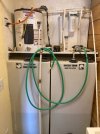richhodg66
Well-Known Member
Been living in a rural setting about seven years now, most of those years have been real wet, this year, not so much, in fact, the state is in a real bad drought.
To make matters worse, a guy bought the ten acre lot adjacent to us, has been living in a 5th wheel on it about a year while he cleared land, earth moved, etc. and is now building a house.
About two weeks ago, turned on the water, nothing. Went for a couple of days which we were out a lot, turned the pump back on and water is back. OK. This weekend, it did the same thing. I have someone coming out to check to make sure all is well with the pump, but I suspect the water table just isn't there.
If that is the case, I suppose the first option is to drill a deeper well?
Nearly everywhere I've lived was on a municipal water source of some type, but I see where Kansas has a rural water association, anuyone know how that works? Seems like you can pay to put in the piping to the nearest main and then have steady water like on a city system, is that right?
I really like living way out from people, hate the idea of moving, but I kind of wonder how to deal with no water if this drought goes on, not wanting to get into climate change, but it sure looks like it's going to be drier for the foreseeable future.
To make matters worse, a guy bought the ten acre lot adjacent to us, has been living in a 5th wheel on it about a year while he cleared land, earth moved, etc. and is now building a house.
About two weeks ago, turned on the water, nothing. Went for a couple of days which we were out a lot, turned the pump back on and water is back. OK. This weekend, it did the same thing. I have someone coming out to check to make sure all is well with the pump, but I suspect the water table just isn't there.
If that is the case, I suppose the first option is to drill a deeper well?
Nearly everywhere I've lived was on a municipal water source of some type, but I see where Kansas has a rural water association, anuyone know how that works? Seems like you can pay to put in the piping to the nearest main and then have steady water like on a city system, is that right?
I really like living way out from people, hate the idea of moving, but I kind of wonder how to deal with no water if this drought goes on, not wanting to get into climate change, but it sure looks like it's going to be drier for the foreseeable future.

